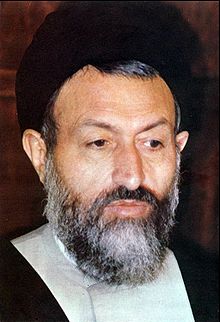- Mohammad Beheshti
-
Seyyed Mohammad Hosseini Beheshti
آیت الله سید محمد حسینی بهشتی
Chief Justice of Iran In office
3 June 1979 – 28 June 1981Appointed by Ruhollah Khomeini Preceded by Vacant Succeeded by Abdul-Karim Mousavi Ardebili Chairman of the Assembly of Experts In office
1 November 1979 – 15 November 1979Preceded by Hussein-Ali Montazeri Succeeded by Ali Meshkini Leader of IRP In office
18 February 1979 – 28 June 1981Deputy Hassan Ayat
Mir-Hossein MousaviPreceded by New party Succeeded by Mohammad-Javad Bahonar Personal details Born October 24, 1928
Isfahan, IranDied June 28, 1981 (aged 52)
Tehran, IranNationality Iranian Political party Islamic Republican Party Children Ali-Reza and Mohammad-Reza Beheshti Alma mater Tehran University Religion Twelver Shi'a Islam Ayatollah Dr. Seyyed Mohammad Hosseini Beheshti (Persian: محمد حسینی بهشتی), (October 24, 1928 - June 28, 1981) was an Iranian scholar, writer, jurist and one of the main architects of the constitution of the Islamic Republic in Iran. He was the secretary-general of the Islamic Republic Party, and the head of Iran's judicial system. He was assassinated together with more than seventy members of the Islamic Republic party on June 28, 1981.
Contents
Biography
Beheshti was born in Isfahan and studied both at the University of Tehran and under Allameh Tabatabaei in Qom. He received
Between 1960 and 1965, he led the Islamic Center in Hamburg [3], where he was responsible for the spiritual leadership of religious Iranian students in Germany and Western Europe. In Hamburg, he also worked with Mohammad Khatami and was among his influences. Since the early 1960s, he was involved in activities against the monarchy and was arrested several times by the Shah's secret police, the SAVAK.
Revolution
Following the Islamic Revolution, he became one of the original members of the Council of Revolution of Iran and soon its chairman. In the first post-revolutionary Iranian parliament, he led the Islamic Republic party together with Ali Akbar Hashemi Rafsanjani. (He never campaigned for the parliament though, as he was already the head of Iran's Supreme Judicial System). He was also planning to run for the presidency in the first presidential elections, but withdrew after Ayatollah Khomeini told a delegation of Rafsanjani and Khamenei that he preferred non-clerics as presidents, which led to the Islamic Republic party's endorsement of first Jalaleddin Farsi and then, inevitably, Abolhassan Banisadr.
Assassination
Beheshti died in terrorist attack on June 28, 1981, when a bomb exploded during a party conference (Hafte tir bombing). The Islamic Republic at first claimed the bomb was planted by the Tudeh Party, then by the People's Mujahedin of Iran organization. The assassin was identified, so the official version, as Mohammad Reza Kolahi, an operative of the People's Mujahedin of Iran.[1]
Ayatollah Khomeini was very moved by his death. During the excavations of the bodies of the bombing victims, Khomeini was walking calmly in the garden of his house. Regularly his trustees would update the Ayatollah with new information on the death toll, Khomeini would not show any physical reaction to this although he was moved. But when they told Khomeini about the possible death of Ayatollah Beheshti, Khomeini turned around put his hands on his back and showed signs of extreme affection.[2]
References
External links
- Islamic Republic of Iran Broadcasting page about Ayatollah Beheshti
- Ayatollah Dr. Beheshti on the elections [4]
Party political offices Preceded by
New PartyLeader of the Islamic Republican Party
1979-1981Succeeded by
Mohammad-Javad BahonarLegal offices Preceded by
VacantHead of Judiciary System of Iran
1979-1981Succeeded by
Abdul-Karim Mousavi ArdebiliPolitical offices Preceded by
Hussein-Ali MontazeriSpeaker of Assembly of Experts
1979Succeeded by
Ali MeshkiniCategories:- 1928 births
- 1981 deaths
- People from Isfahan
- Iranian ayatollahs
- Iranian heads of Judicial System
- People murdered in Iran
- Iranian terrorism victims
- Islamic Republican Party politicians
- Speakers of the Assembly of Experts
Wikimedia Foundation. 2010.
